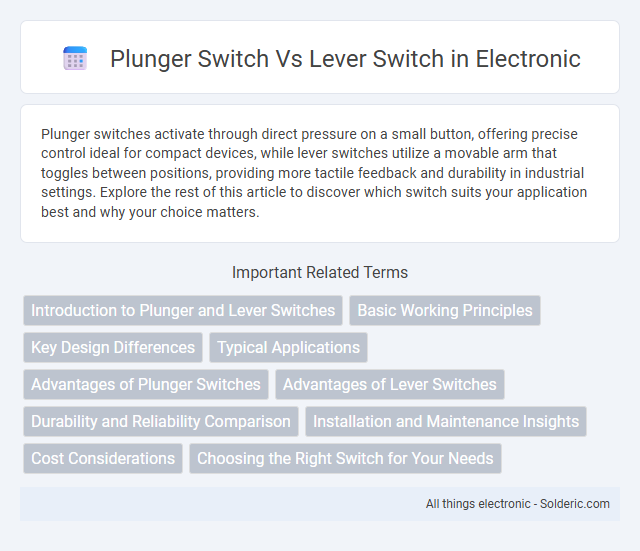Plunger switches activate through direct pressure on a small button, offering precise control ideal for compact devices, while lever switches utilize a movable arm that toggles between positions, providing more tactile feedback and durability in industrial settings. Explore the rest of this article to discover which switch suits your application best and why your choice matters.
Comparison Table
| Feature | Plunger Switch | Lever Switch |
|---|---|---|
| Operation Type | Push-button activation by pressing plunger | Toggle activation by moving lever |
| Actuation Force | Usually requires direct linear force | Requires angular force to pivot lever |
| Typical Applications | Doorbells, limit switches, safety interlocks | Industrial machinery controls, power tools, circuit breakers |
| Durability | Moderate, depends on design and materials | High, designed for frequent toggling |
| Size | Generally compact and small | Usually larger due to lever mechanism |
| Reset Mechanism | Automatic spring return to original position | Manual reset required by moving lever back |
| Contact Type | Momentary contact | Maintained contact (on/off states) |
Introduction to Plunger and Lever Switches
Plunger switches are mechanical devices activated by linear motion to open or close electrical circuits, commonly used in industrial machinery for precise control. Lever switches operate through angular or rotational movement of a lever arm, enabling quick toggling in applications such as limit switches or safety interlocks. Both switch types provide reliable contact operation but differ in actuation style and suitability for specific mechanical setups.
Basic Working Principles
A plunger switch operates by pressing a spring-loaded button or plunger that completes or interrupts an electrical circuit when pushed. In contrast, a lever switch uses a pivoting arm or lever to make or break a connection, often allowing for multiple positions or toggling actions. Your choice depends on application needs, as plunger switches are ideal for momentary contact, while lever switches suit stable, maintained connections.
Key Design Differences
Plunger switches feature a cylindrical actuator that moves linearly when pressed, ideal for precise on/off activation in compact spaces. Lever switches use a pivoting arm that provides greater mechanical advantage and versatility, often preferred for toggling functions with varied motion ranges. Your choice depends on application needs--plunger switches excel in momentary contact scenarios, while lever switches offer durable, reliable toggling for continuous use.
Typical Applications
Plunger switches are commonly used in safety mechanisms and limit detection systems, such as elevator door controls and industrial machinery position sensing. Lever switches find typical applications in controlling mechanical devices that require manual or automatic actuation, like vending machines, automotive lighting controls, and alarm systems. Understanding your specific needs can help determine whether the precise actuation of a plunger switch or the versatility of a lever switch is most suitable for your application.
Advantages of Plunger Switches
Plunger switches offer precise activation through direct mechanical movement, ensuring reliable and consistent switching in various applications such as industrial machinery and safety devices. Their compact design allows for easy integration into tight spaces, enhancing versatility and installation flexibility. Additionally, plunger switches provide high durability and resistance to environmental factors, making them ideal for harsh or demanding operational conditions.
Advantages of Lever Switches
Lever switches offer greater durability and a higher mechanical lifespan compared to plunger switches, making them ideal for applications requiring frequent activation. They provide more tactile feedback and ergonomic operation, enhancing user control and reducing fatigue. Lever switches also tend to accommodate higher current loads, increasing their suitability for industrial and heavy-duty electrical systems.
Durability and Reliability Comparison
Plunger switches offer high durability due to their simple mechanical design, making them less prone to wear and failure in harsh environments. Lever switches provide reliable performance with added flexibility in activation angles, but their moving parts may experience more mechanical stress over time. Your choice depends on whether you prioritize long-lasting robustness or precise mechanical control in your application.
Installation and Maintenance Insights
Plunger switches install easily into confined spaces, requiring minimal wiring and providing straightforward mechanical operation, while lever switches demand more clearance and precise alignment during installation. Maintenance for plunger switches involves regular inspection of the actuator for debris buildup and spring tension, ensuring consistent contact activation. Lever switches necessitate periodic lubrication and adjustment of the pivot mechanism to maintain smooth movement and reliable electrical connections.
Cost Considerations
Plunger switches generally cost less due to simpler design and fewer materials used, making them ideal for budget-sensitive projects. Lever switches, while slightly more expensive, offer greater durability and versatility, potentially reducing long-term maintenance costs. Your choice should balance initial expenses against operational longevity and application-specific requirements.
Choosing the Right Switch for Your Needs
Plunger switches offer precise, momentary activation ideal for applications requiring quick, tactile feedback, while lever switches provide greater mechanical advantage and are suited for environments demanding robust, sustained switching actions. Selecting the right switch depends on factors such as load capacity, activation style, durability, and the specific mechanical interface required. Understanding the operational context and performance specifications ensures optimal functionality and longevity in your electrical or electronic projects.
Plunger switch vs Lever switch Infographic

 solderic.com
solderic.com